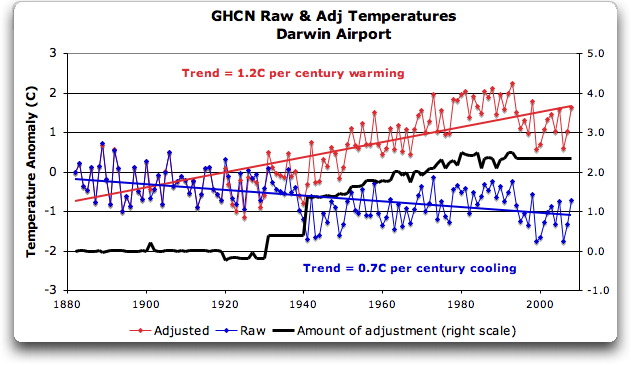It appears the esteemed IPCC folks made a wee error of about 300 years regarding melting glaciers...
____
Despite the Al-Gore-Kool-Aid-drinkers best efforts to suppress it, the Climategate scandal continues to blossom and flourish. (Or should that be putresce and pullulate?)
I think my favourite comic detail this week just has to be the one about the amazing not-so-fast-shrinking glaciers. As youll know if youve been reading reports like this scare stories about glaciers retreating faster than predicted are a central plank of the IPCCs case that we should carbon-tax ourselves back to the Dark Ages NOW. According to the IPCC, the Himalayan glaciers could be gone by 2035.
Or should that be 2350? Yep it seems those scientific experts who make the IPCCs reports so famously reliable and trustworthy have a bad case of numerical dyslexia. The mistake was spotted by a Canadian academic:
J Graham Cogley, a professor at Ontario Trent University, says he believes the UN authors got the date from an earlier report wrong by more than 300 years.
He is astonished they misread 2350 as 2035″.
In its 2007 report, the Nobel Prize-winning Inter-governmental Panel on Climate Change (IPCC) said: Glaciers in the Himalayas are receding faster than in any other part of the world and, if the present rate continues, the likelihood of them disappearing by the year 2035 and perhaps sooner is very high if the Earth keeps warming at the current rate.
Its total area will likely shrink from the present 500,000 to 100,000 square kilometres by the year 2035, the report said.
It suggested three quarters of a billion people who depend on glacier melt for water supplies in Asia could be affected.
But Professor Cogley has found a 1996 document by a leading hydrologist, VM Kotlyakov, that mentions 2350 as the year by which there will be massive and precipitate melting of glaciers.
The extrapolar glaciation of the Earth will be decaying at rapid, catastrophic rates its total area will shrink from 500,000 to 100,000 square kilometres by the year 2350, Mr Kotlyakovs report said.
Mr Cogley says it is astonishing that none of the 10 authors of the 2007 IPCC report could spot the error and misread 2350 as 2035″.
I do suggest that the glaciological community might consider advising the IPCC about ways to avoid such egregious errors as the 2035 versus 2350 confusion in the future, says Mr Cogley.
Full article here:
Climategate: another smoking gun… – Telegraph Blogs
____
Despite the Al-Gore-Kool-Aid-drinkers best efforts to suppress it, the Climategate scandal continues to blossom and flourish. (Or should that be putresce and pullulate?)
I think my favourite comic detail this week just has to be the one about the amazing not-so-fast-shrinking glaciers. As youll know if youve been reading reports like this scare stories about glaciers retreating faster than predicted are a central plank of the IPCCs case that we should carbon-tax ourselves back to the Dark Ages NOW. According to the IPCC, the Himalayan glaciers could be gone by 2035.
Or should that be 2350? Yep it seems those scientific experts who make the IPCCs reports so famously reliable and trustworthy have a bad case of numerical dyslexia. The mistake was spotted by a Canadian academic:
J Graham Cogley, a professor at Ontario Trent University, says he believes the UN authors got the date from an earlier report wrong by more than 300 years.
He is astonished they misread 2350 as 2035″.
In its 2007 report, the Nobel Prize-winning Inter-governmental Panel on Climate Change (IPCC) said: Glaciers in the Himalayas are receding faster than in any other part of the world and, if the present rate continues, the likelihood of them disappearing by the year 2035 and perhaps sooner is very high if the Earth keeps warming at the current rate.
Its total area will likely shrink from the present 500,000 to 100,000 square kilometres by the year 2035, the report said.
It suggested three quarters of a billion people who depend on glacier melt for water supplies in Asia could be affected.
But Professor Cogley has found a 1996 document by a leading hydrologist, VM Kotlyakov, that mentions 2350 as the year by which there will be massive and precipitate melting of glaciers.
The extrapolar glaciation of the Earth will be decaying at rapid, catastrophic rates its total area will shrink from 500,000 to 100,000 square kilometres by the year 2350, Mr Kotlyakovs report said.
Mr Cogley says it is astonishing that none of the 10 authors of the 2007 IPCC report could spot the error and misread 2350 as 2035″.
I do suggest that the glaciological community might consider advising the IPCC about ways to avoid such egregious errors as the 2035 versus 2350 confusion in the future, says Mr Cogley.
Full article here:
Climategate: another smoking gun… – Telegraph Blogs
